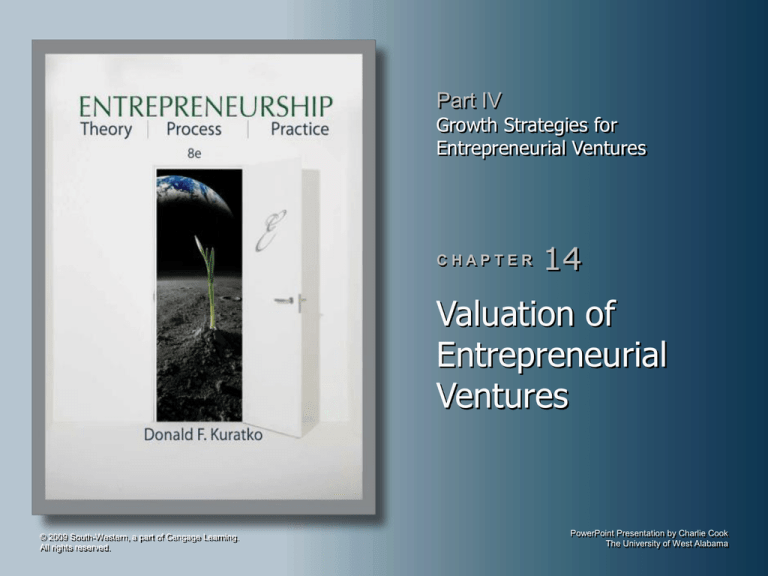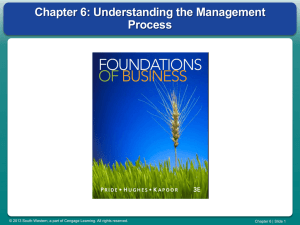
Part IV
Growth Strategies for
Entrepreneurial Ventures
CHAPTER
14
Valuation of
Entrepreneurial
Ventures
© 2009 South-Western, a part of Cengage Learning.
All rights reserved.
PowerPoint Presentation by Charlie Cook
The University of West Alabama
Chapter Objectives
1. To explain the importance of valuation
2. To describe the basic elements of due diligence
3. To examine the underlying issues involved in the
acquisition process
4. To outline the various aspects of analyzing a
business
5. To present the major points to consider when
establishing a firm’s value
6. To highlight the available methods of valuing a
venture
© 2009 South-Western, a part of Cengage Learning. All rights reserved.
14–2
Chapter Objectives
7. To examine the three principal methods currently
used in business valuations
8. To consider additional factors affecting a venture’s
valuation
© 2009 South-Western, a part of Cengage Learning. All rights reserved.
14–3
The Importance of Business Valuation
• Business valuation is essential when:
Buying or selling a business, division, or major asset
Establishing an employee stock option plan (ESOP) or profitsharing plan for employees
Raising growth capital through stock warrants or convertible
loans
Determining inheritance tax liability (potential estate tax liability)
Giving a gift of stock to family members
Structuring a buy/sell agreement with stockholders
Attempting to buy out a partner
Going public with the company or privately placing the stock
© 2009 South-Western, a part of Cengage Learning. All rights reserved.
14–4
Underlying Issues When Acquiring a Venture
Differing Goals of
Buyer and Seller
Emotional Bias
of the Seller
Valuation of the
Venture
Reasons for
the Acquisition
© 2009 South-Western, a part of Cengage Learning. All rights reserved.
14–5
Reasons for an Acquisition
• To gain access to new products or expand the existing
product line
• To increase the number of customers and market share
• To integrate vertically, backward or forward to improve
supply and distribution channels and to reduce inventory
levels
• To develop or improve customer service functions
• To reduce indirect and direct operating costs and fixed
costs by using excess production and service capacities
and by eliminating duplicated operations
© 2009 South-Western, a part of Cengage Learning. All rights reserved.
14–6
Evaluation of an Acquisition
• A firm’s potential to pay for itself during a reasonable
period of time
• The difficulties that the new owners will face during the
transition period
• The amount of security or risk involved in the
transaction; changes in interest rates
• The effect on the firm’s value if a turnaround is required
• The number of potential buyers
• Current managers’ intentions to remain with the firm
• The taxes associated with the purchase or sale of the
enterprise
© 2009 South-Western, a part of Cengage Learning. All rights reserved.
14–7
Due Diligence Questions
• Why is this business being sold?
• What is the physical condition of the business?
• How many key personnel will remain?
• What is the degree of competition?
• What are the conditions of the lease?
• Do any liens against the business exist?
• Will the owner sign a covenant not to compete?
• Are any special licenses required?
• What are the future trends of the business?
• How much capital is needed to buy?
© 2009 South-Western, a part of Cengage Learning. All rights reserved.
14–8
Figure
14.1
Total Amount Needed to Buy a Business
NOTE: Money for living and business expenses for at least three months should be set aside in a bank savings account and not
used for any other purpose. This is a cushion to help get through the start-up period with a minimum of worry. If expense money
for a longer period can be provided, it will add to peace of mind and help the buyer concentrate on building the business.
© 2009 South-Western, a part of Cengage Learning. All rights reserved.
14–9
Analyzing the Business
• Many closely held ventures have the following
shortcomings:
Lack of management depth
Undercapitalization
Insufficient controls
Divergent goals
© 2009 South-Western, a part of Cengage Learning. All rights reserved.
14–10
Establishing A Firm’s Value
• Valuation Methods
Adjusted Tangible Book Value
• Computing a firm’s net worth as the difference between total
assets and total liabilities; adjusting the value of assets to
reflect their true economic worth such as balance sheet and
income statement adjustments that include:
– bad debt reserves
– low-interest, long-term debt securities
– investments in affiliates
– loans and advances to officers, employees, or other
companies
© 2009 South-Western, a part of Cengage Learning. All rights reserved.
14–11
Establishing A Firm’s Value (cont’d)
• Valuation Methods (cont’d)
Price/Earnings Ratio (Multiple of Earnings) Method
• Useful in valuing publicly held corporations.
• Valuation is determined by dividing the market price of the
common stock by the earnings per share.
• Major drawbacks:
– The stock of a private company is not publicly traded.
– The stated net income of a private company may not truly
reflect its actual earning power.
– The sale of a large controlling block of stock of closely
held business can command a premium.
– It is very difficult to find a truly comparable publicly held
company, even in the same industry.
© 2009 South-Western, a part of Cengage Learning. All rights reserved.
14–12
Establishing A Firm’s Value
• Valuation Methods (cont’d)
Discounted Earnings Method
• The firm’s discounted cash flows are dollars earned in the
future (based on projections) that worth less than dollars
earned today (due to the loss of purchasing power).
• With this in mind, the “timing” of projected income or cash
flows is a critical factor.
The process of discounting cash flows:
•
•
•
•
Expected cash flow is estimated.
An appropriate discount rate is determined.
A reasonable life expectancy of the firm is determined.
The firm’s value is determined by discounting the estimated
cash flow by the appropriate discount rate over the expected
life of the business.
© 2009 South-Western, a part of Cengage Learning. All rights reserved.
14–13
Term Sheets in Venture Valuation
• Term Sheet
Outlines the material terms and conditions of a
venture agreement and guides legal counsel in the
preparation of a proposed final agreement.
Are very similar to letters of intent (LOI) in that they
are both preliminary, mostly nonbinding documents
meant to record two or more parties’ intentions to
enter into a future agreement based on specified (but
incomplete or preliminary) terms.
© 2009 South-Western, a part of Cengage Learning. All rights reserved.
14–14
Figure
14.2
The Pricing Formula
Step 1. Determine the adjusted tangible net worth of the business (the total market value of
all current and long-term assets less liabilities).
Step 2. Estimate how much the buyer could earn annually with an amount equal to the
value of the tangible net worth invested elsewhere.
Step 3. Add to this a salary normal for an owner/operator of the business. This combined
figure provides a reasonable estimate of the income the buyer can earn elsewhere
with the investment and effort involved in working in the business.
Step 4. Determine the average annual net earnings of the business (net profit before
subtracting owner’s salary) over the past few years.
Step 5. Subtract the total of earning power (2) and reasonable salary (3) from this average
net earnings figure (4). This gives the extra earning power of the business.
Step 6. Use this extra earnings figure to estimate the value of the intangibles. This is done
by multiplying the extra earnings by what is termed the “years-of-profit” figure.
Step 7. Final price equals adjusted tangible net worth plus value of intangibles (extra
earnings times “years of profit”).
Source: Reprinted with permission from Bank of America NT&SA, “How to Buy and
Sell a Business or Franchise,” Small Business Reporter, copyright ©1987, 17.
© 2009 South-Western, a part of Cengage Learning. All rights reserved.
14–15
Figure
14.2
The Pricing Formula (cont’d)
In example A, the seller receives a value for goodwill because the business is moderately well
established and earning more than the buyer could earn elsewhere with similar risks and effort.
In example B, the seller receives no value for goodwill because the business, even though it may
have existed for a considerable time, is not earning as much as the buyer could through outside
investment and effort. In fact, the buyer may feel that even an investment of $100,000—the current
appraised value of net assets—is too much because it cannot earn sufficient return.
a This
is an arbitrary figure, used for illustration. A reasonable figure depends on the stability and relative risks of the business and the investment picture generally.
The rate of return should be similar to that which could be earned elsewhere with the same approximate risk.
Source: Reprinted with permission from Bank of America NT&SA, “How to Buy and
Sell a Business or Franchise,” Small Business Reporter, copyright ©1987, 17.
© 2009 South-Western, a part of Cengage Learning. All rights reserved.
14–16
Terms in Letters of Intent (LOI)
• Price/Valuation
• Conversion Rights
• Fully Diluted Ownership
• Antidilution Protection
• Type of Security
• Ratchet protection
Convertible preferred stock
• Liquidation Preference
• Dividend Preference
Cumulative
Noncumulative and
discretionary
• Redemption Preferred
Optional
Mandatory
© 2009 South-Western, a part of Cengage Learning. All rights reserved.
Price protection
• Weighted average protection
• Voting Rights
• Right of First Refusal
• Co-Sale Right
• Registration Rights
Piggyback rights
Demand rights
• Vesting on Founders’ Stock
14–17
Other Factors to Consider
• Additional factors that may influence the final
valuation of the venture:
Avoiding start-up costs
• Buyers are willing to pay more than the evaluated price for an
existing firm to avoid start-up costs.
Accuracy of projections
• The sales and earnings of a venture are always projected on
the basis of historical financial and economic data.
Control factor
• The degree of control an owner legally has over the firm can
affect its valuation; more control, more value.
© 2009 South-Western, a part of Cengage Learning. All rights reserved.
14–18
Key Terms and Concepts
• adjusted tangible book
value
• anti-dilution protection
• business valuation
• control factor
• discounted earnings
method
• divergent goals
© 2009 South-Western, a part of Cengage Learning. All rights reserved.
• due diligence
• emotional bias
• fully diluted
• letter of intent (LOI)
• liquidation preference
• price/earnings ratio (P/E)
• term sheet
• undercapitalization
14–19





